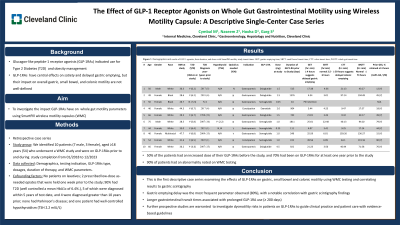Sunday Poster Session
Category: Functional Bowel Disease
P0637 - The Effect of GLP-1 Receptor Agonists on Whole Gut Gastrointestinal Motility Using Wireless Motility Capsule
Sunday, October 27, 2024
3:30 PM - 7:00 PM ET
Location: Exhibit Hall E

Has Audio

Michael Cymbal, DO
Cleveland Clinic Foundation
Cleveland, OH
Presenting Author(s)
Michael Cymbal, DO, Zehra Naseem, MD, Din Hoxha, MD, Samita Garg, MD
Cleveland Clinic Foundation, Cleveland, OH
Introduction: Glucagon-like peptide-1 receptor agonists (GLP-1RAs) are recommended for patients with Type 2 Diabetes (T2D) with and without obesity. GLP-1 is secreted from the L cells of the lower intestine, and its mechanism of action includes central effects on satiety and delayed gastric emptying. GLP-1RAs effects on gastric, small bowel and colonic motility are not well defined. We utilized our SmartPill wireless motility capsule (WMC) database to define whole gut motility parameters in people treated with GLP-1RAs.
Methods: We identified 10 patients, 7 male and 3 female, age ≥18 years, who were on GLP-1RAs prior to and during the WMC study from 01/2018 to 12/2023. We evaluated GLP-1RAs type, dosages, duration of therapy, testing indication, and WMC parameters. Along with potential confounding factors including additional GI dysmotility agents, hypothyroidism, neurological conditions, T2D duration and control.
Results: The mean age of the patients was 54.0 years. The most common indication (n=8) for WMC study was diagnosed gastroparesis via gastric emptying study and 2 patients had chronic constipation. All patients were not on laxatives and 2 prescribed low-dose as-needed opiates that were held one week prior to the study. 90% of the patients had T2D, 5 of which were diagnosed within 5 years of test date, and 4 were diagnosed greater than 10 years prior. T2D was well-controlled at the time of the study, with a mean HbA1c of 6.4%. None of the patients had Parkinson’s disease, and one patient had well-controlled hypothyroidism (TSH 2.2 mIU/L). Additionally, 50% of the patients had an increased dose of their GLP-1RAs before the study, and 70% had been on GLP-1RAs for at least one year prior to the study. Gastrointestinal transit times from the WMC study are detailed in Table 1a, and demographics are shown in Table 1b.
Discussion: This is a retrospective observation highlighting the effects of GLP-1RAs on gastric, small bowel and colonic motility using WMC testing and correlating results to gastric scintigraphy. Gastric emptying delay was the most frequent dysmotility parameter and was noted to be severely delayed despite good control of T2D. This finding corresponded to delay noted on gastric scintigraphy on GLP-1RAs. Moreover, patients on GLP-1RAs for 200 days or more had longer gastrointestinal transition times. Prospective studies are needed to better understand dysmotility in people on GLP-1RAs to better guide patients and providers on the risks of GLP-1RAs.
Note: The table for this abstract can be viewed in the ePoster Gallery section of the ACG 2024 ePoster Site or in The American Journal of Gastroenterology's abstract supplement issue, both of which will be available starting October 27, 2024.
Disclosures:
Michael Cymbal, DO, Zehra Naseem, MD, Din Hoxha, MD, Samita Garg, MD. P0637 - The Effect of GLP-1 Receptor Agonists on Whole Gut Gastrointestinal Motility Using Wireless Motility Capsule, ACG 2024 Annual Scientific Meeting Abstracts. Philadelphia, PA: American College of Gastroenterology.
Cleveland Clinic Foundation, Cleveland, OH
Introduction: Glucagon-like peptide-1 receptor agonists (GLP-1RAs) are recommended for patients with Type 2 Diabetes (T2D) with and without obesity. GLP-1 is secreted from the L cells of the lower intestine, and its mechanism of action includes central effects on satiety and delayed gastric emptying. GLP-1RAs effects on gastric, small bowel and colonic motility are not well defined. We utilized our SmartPill wireless motility capsule (WMC) database to define whole gut motility parameters in people treated with GLP-1RAs.
Methods: We identified 10 patients, 7 male and 3 female, age ≥18 years, who were on GLP-1RAs prior to and during the WMC study from 01/2018 to 12/2023. We evaluated GLP-1RAs type, dosages, duration of therapy, testing indication, and WMC parameters. Along with potential confounding factors including additional GI dysmotility agents, hypothyroidism, neurological conditions, T2D duration and control.
Results: The mean age of the patients was 54.0 years. The most common indication (n=8) for WMC study was diagnosed gastroparesis via gastric emptying study and 2 patients had chronic constipation. All patients were not on laxatives and 2 prescribed low-dose as-needed opiates that were held one week prior to the study. 90% of the patients had T2D, 5 of which were diagnosed within 5 years of test date, and 4 were diagnosed greater than 10 years prior. T2D was well-controlled at the time of the study, with a mean HbA1c of 6.4%. None of the patients had Parkinson’s disease, and one patient had well-controlled hypothyroidism (TSH 2.2 mIU/L). Additionally, 50% of the patients had an increased dose of their GLP-1RAs before the study, and 70% had been on GLP-1RAs for at least one year prior to the study. Gastrointestinal transit times from the WMC study are detailed in Table 1a, and demographics are shown in Table 1b.
Discussion: This is a retrospective observation highlighting the effects of GLP-1RAs on gastric, small bowel and colonic motility using WMC testing and correlating results to gastric scintigraphy. Gastric emptying delay was the most frequent dysmotility parameter and was noted to be severely delayed despite good control of T2D. This finding corresponded to delay noted on gastric scintigraphy on GLP-1RAs. Moreover, patients on GLP-1RAs for 200 days or more had longer gastrointestinal transition times. Prospective studies are needed to better understand dysmotility in people on GLP-1RAs to better guide patients and providers on the risks of GLP-1RAs.
Note: The table for this abstract can be viewed in the ePoster Gallery section of the ACG 2024 ePoster Site or in The American Journal of Gastroenterology's abstract supplement issue, both of which will be available starting October 27, 2024.
Disclosures:
Michael Cymbal indicated no relevant financial relationships.
Zehra Naseem indicated no relevant financial relationships.
Din Hoxha indicated no relevant financial relationships.
Samita Garg indicated no relevant financial relationships.
Michael Cymbal, DO, Zehra Naseem, MD, Din Hoxha, MD, Samita Garg, MD. P0637 - The Effect of GLP-1 Receptor Agonists on Whole Gut Gastrointestinal Motility Using Wireless Motility Capsule, ACG 2024 Annual Scientific Meeting Abstracts. Philadelphia, PA: American College of Gastroenterology.
